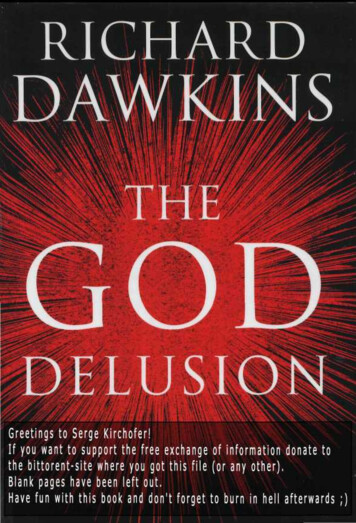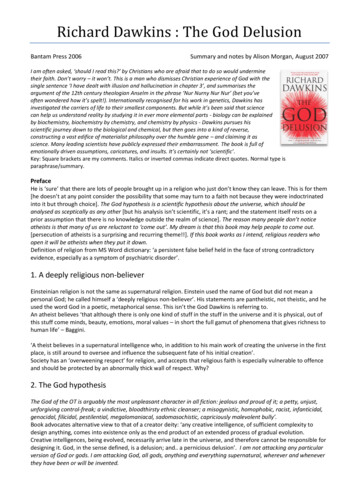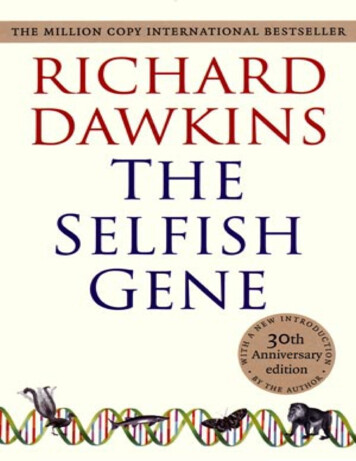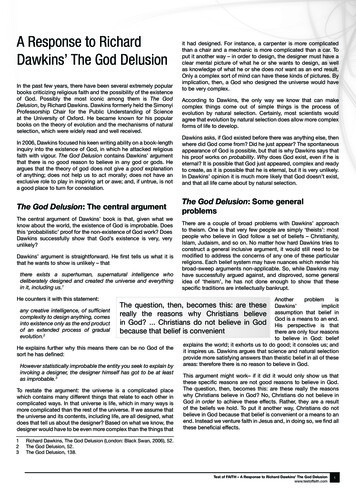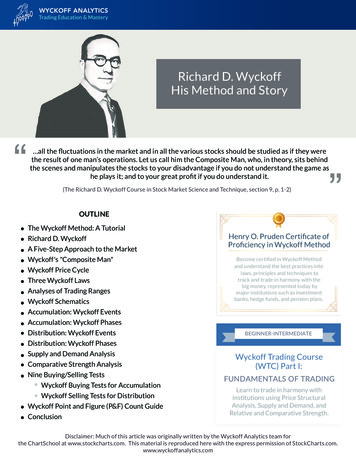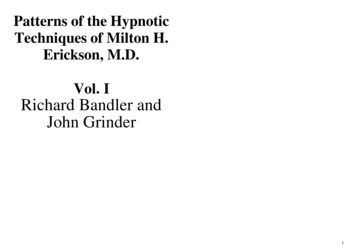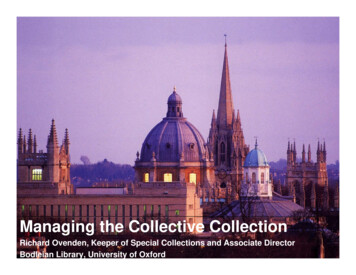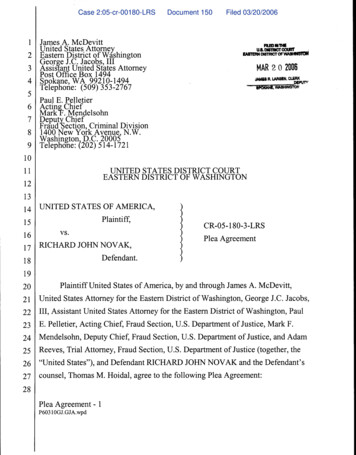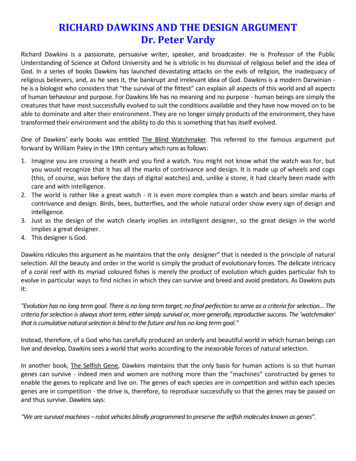
Transcription
RICHARD DAWKINS AND THE DESIGN ARGUMENTDr. Peter VardyRichard Dawkins is a passionate, persuasive writer, speaker, and broadcaster. He is Professor of the PublicUnderstanding of Science at Oxford University and he is vitriolic in his dismissal of religious belief and the idea ofGod. In a series of books Dawkins has launched devastating attacks on the evils of religion, the inadequacy ofreligious believers, and, as he sees it, the bankrupt and irrelevant idea of God. Dawkins is a modern Darwinian he is a biologist who considers that "the survival of the fittest" can explain all aspects of this world and all aspectsof human behaviour and purpose. For Dawkins life has no meaning and no purpose - human beings are simply thecreatures that have most successfully evolved to suit the conditions available and they have now moved on to beable to dominate and alter their environment. They are no longer simply products of the environment, they havetransformed their environment and the ability to do this is something that has itself evolved.One of Dawkins' early books was entitled The Blind Watchmaker. This referred to the famous argument putforward by William Paley in the 19th century which runs as follows:1. Imagine you are crossing a heath and you find a watch. You might not know what the watch was for, butyou would recognize that it has all the marks of contrivance and design. It is made up of wheels and cogs(this, of course, was before the days of digital watches) and, unlike a stone, it had clearly been made withcare and with intelligence.2. The world is rather like a great watch - it is even more complex than a watch and bears similar marks ofcontrivance and design. Birds, bees, butterflies, and the whole natural order show every sign of design andintelligence.3. Just as the design of the watch clearly implies an intelligent designer, so the great design in the worldimplies a great designer.4. This designer is God.Dawkins ridicules this argument as he maintains that the only designer" that is needed is the principle of naturalselection. All the beauty and order in the world is simply the product of evolutionary forces. The delicate intricacyof a coral reef with its myriad coloured fishes is merely the product of evolution which guides particular fish toevolve in particular ways to find niches in which they can survive and breed and avoid predators. As Dawkins putsit:"Evolution has no long term goal. There is no long term target, no final perfection to serve as a criteria for selection. Thecriteria for selection is always short term, either simply survival or, more generally, reproductive success. The 'watchmaker'that is cumulative natural selection is blind to the future and has no long term goal."Instead, therefore, of a God who has carefully produced an orderly and beautiful world in which human beings canlive and develop, Dawkins sees a world that works according to the inexorable forces of natural selection.In another book, The Selfish Gene, Dawkins maintains that the only basis for human actions is so that humangenes can survive - indeed men and women are nothing more than the "machines" constructed by genes toenable the genes to replicate and live on. The genes of each species are in competition and within each speciesgenes are in competition - the drive is, therefore, to reproduce successfully so that the genes may be passed onand thus survive. Dawkins says:“We are survival machines – robot vehicles blindly programmed to preserve the selfish molecules known as genes”.
Human beings have evolved to meet the conditions available. There is no purpose and no meaning to our existenceexcept to replicate. Religion is based on a sense of personal inadequacy and the unwillingness to face the clearevidence of science. Human beings are unwilling to recognize their position as highly evolved animals and thereforehave sought, from primitive times, to tell themselves stories that they have been created by a great father figure inthe sky - this enables humans to think that their lives have meaning and significance when in fact this meaning isentirely lacking.Dawkins understands human beings strictly in terms of biology - we have about 5 billion cells each containing46 chromosomes. Each chromosome contains tens of thousands of genes. Our DNA is passed on through ourgenes and, therefore, there is a sense in which the real essence of who we are, our DNA, is transmitted whenwe breed. Our DNA lives on in our children and we preserve our DNA by breeding. Our DNA represents thevery essence of who each human being is just as it represents the essence of every living thing in the world.Dawkins puts this as follows:"It is raining DNA outside. On the banks of the Oxford canal at the bottom of my garden is a large willow tree and it ispumping downy seeds into the air. not just any DNA but DNA whose coded characteristics spell out specific instructionsfor building willow trees that will shed a new generation of downy seeds. These fluffy specks are, literally, spreadinginstructions for making themselves. They are there because their ancestors succeeded in doing the same. It's raininginstructions out there. It's raining programmes; it's raining tree-growing, fluff-spreading algorithms. This is not ametaphor, it is the plain truth. It couldn't be plainer if it were raining floppy discs." (The Blind Watchmaker 1986 p.111)Peter Williams, a modern theistic philosopher, agrees with Dawkins that there is a strong analogy betweenDNA and a computer disc but he maintains that just as we know that computer programs come from minds,we should similarly assume that DNA comes from a mind - the mind of God. Science, he argues, falls silentwhen asked for an explanation for the ultimate nature of the natural laws that give rise to order and thatgenerate the processes that brings DNA about. He quotes Michael Behe:"If you search the scientific literature on evolution, and if you focus your search on the question of how molecularmachines - the basis of life - developed, you find an eerie and complete silence." For example, the Journal of MolecularEvolution was established in 1971, and is dedicated to explaining how life came to be at the molecular level. None of thepapers published in GME has ever proposed a possible route for a single complex biochemical system to arise in a gradualstep-by-step Darwinian process."This, however, is not a good argument against Dawkins - it is effectively a "God of the gaps" argument as it ismaintaining that as scientists have not yet discovered how organic life forms from inorganic, then God must be responsible. This type of argument has been put forward by generations of theistic philosophers and scientists but it isvulnerable to the next scientific discovery which may discover the explanation for what is presently inexplicable.Williams maintains that a supernatural origin is required not for the DNA itself but for the processes which bring theDNA about:"To say that Darwinian evolution cannot explain everything in nature is not to say that evolution, randommutation, and natural selection do not occur; they have been observed (at least in the case of microevolution)many different times. I believe the evidence strongly supports common descent. But the root questionremain unanswered; what has caused complex systems to form?" (M Behe Darwin's Black Box pp.175-6)In other words, the principle of natural selection does not rule out belief in God - the question still remains as towhere the whole system comes from and this, it is claimed, science cannot explain.
Dawkins sets up religious perspectives which are banal and then finds these an easy target to knock down. He shared aplatform with John Polkinghorne and Peter Vardy in Manchester and London Universities in 2001 and in hispresentation Dawkins gave the example of a U.S. Christian website which pointed to the following features of abanana as being designed by God: Outward indicator of inner contents: green - not ready; yellow - ready; and black-over-ripe.It is curved toward the mouth.Has non-slip surface.Bio-degradable.Tab for removal of wrapper.Shaped for human hand.Perforated for ease of access.Pleasing to taste buds.It has a specially designed "unzipper" for ease.It is nutritious.Dawkins then proceeds to mock religious believers who hold such banal and foolish positions. Of course he is right, butchallenging religious belief on the basis of an argument that a child of seven would not accept is hardly a positionworthy of a serious thinker. He does the same in his argument against believers who claim their position is rationalbecause it cannot be disproved:"Theists say: 'You can't prove a negative. Science has no way to disprove the existence of a supreme being.' (this is strictlytrue). Therefore, belief or disbelief in a supreme being is a matter of pure, individual inclination, and both are thereforeequally deserving of respectful attention! When you say it like that, the fallacy is almost self-evident; we hardly need spellout the reductio ad absurdum. As my colleague, the physical chemist Peter Atkins, puts it, we must be equally agnosticabout the theory that there is a teapot in orbit around the planet Pluto. We can't disprove it. But that doesn't mean thetheory that there is a teapot is on level terms with the theory that there isn't. Now, if it be retorted that there actually arereasons X, Y, and Z for finding a supreme being more plausible than a teapot, then X, Y, and Z should be spelled out."This simply will not do - as Wittgenstein said "for a blunder, that's too big."2 There is not a single serious theologian inChristianity, Islam, or Judaism who thinks that God is in any way whatever like a teapot or any other sort of physicalobject located at a particular space and time. As this book has made clear, theologians are far more sophisticatedthan this. God is the god of the Universe and transcends the normal categories of objects within the Universe. God isde re necessary, necessary in and of God's self and in a completely different category to physical objects. Also, noreligious believers speak as Dawkins portrays them as speaking. It may be true that there is no good scientificevidence for God (and in demanding this Dawkins is showing that he is a closet verificationist) but that does not meanthat there are not good reasons to believe in God and that these reasons cannot be evaluated, probed, examined,and questioned - as this book has attempted to do. Dawkins' lack of awareness of theology and also of the profoundphilosophical thought that, for more than 2000 years, has engaged with and been preoccupied by the issue of God'sexistence radically undermines the effectiveness of his attacks.In his latest books, Dawkins has developed a real spiritual sense grounded in a feeling of awe and wonder at theUniverse:"The spotlight passes but, exhilaratingly, before doing so it gives us time to comprehend something of thisplace in which we fleetingly find ourselves and the reason that we do so. We are alone among animals in beingable to say before we die: Yes, this is why it was worth coming to life in the first place." (Unweaving theRainbow pp.312-3)
"After sleeping through a hundred million centuries we have finally opened our eyes on a sumptuous planet, sparkling withcolor, beautiful with life. Within decades we must close our eyes again. Isn't it a noble, enlightened way of spending ourbrief time in the Sun, to work at understanding the Universe and how we have come to wake up on it." (op. cit. p.6)Dawkins, however, is quick to refute suggestions that this sense of wonder has anything in common with religion indeed he is dismissive and highly critical of those scientists who, he sees, as "cashing in" on religious interest inscience and who connect a sense of wonder and awe at the Universe with some form of religious imperative. For Dawkins,the Universe is a blind accident, but nevertheless something about which human beings can rightly wonder in theshort time that we are alive.Dawkins is dismissive of those theistic philosophers who argue that the sheer improbability of the world makes itlikely that there is a God. Richard Swinburne is one philosopher who asks his reader to imagine a madman whokidnaps his victim and ties him to a chair underneath which is some explosive. This explosive is attached to tenmachines, each of which shuffles a pack of playing cards. The madman leaves his victim saying to him that theexplosive will detonate unless each of the randomly shuffled packs of cards comes up with an ace of hearts. Thechances of this happening are incredible small - 144,555,105,949,057,024 to one.3 The victim waits, watchingthe cards. When the explosive does not go off and the victim sees that every single one of the cards has come upwith the desired ace, he will be convinced, argues Swinburne, that this could not have happened by chance. Thecard shuffling machines must have been fixed in some way, it cannot just be an accident. Similarly, arguesSwinburne, the chances of the exact conditions being present for human beings to exist are so slim that there musthave been a designer - namely God.Russell Stannard, former Professor of Theoretical Physics at The Open University gives a similar example. Imaginethat a prisoner is blindfolded and taken before a firing squad. The firing squad is made up of trained marksmen they never miss. The marksmen all take aim at point blank range and they all fire, and every single one of themmisses. Surely, Stannard argues, the prisoner would be right in thinking that this was not merely chance someone must have given orders that the marksmen would miss. It is simply too improbable that every singleone could do so as a result of chance. Dawkins rejects these arguments and sees them as being based on a falseand naive premise.The difference between Swinburne and Dawkins can be explained by the following example. Imagine that tenpacks of cards are shuffled and the cards that appear are:5H; 7C; 2S; AD; 2D; QS; 9C; KH; 2D; 5H1. The odds of this combination coming up are astronomical. Swinburne and Stannard claim that the chances ofhuman beings having evolved are similarly slim and, therefore, an intelligence must be assumed that arrangedconditions so that this incredibly unlikely scenario comes into being.2. Dawkins, by contrast, maintains that the cards are just what happened to come up. Similarly human beings arejust what happened to evolve to suit the conditions available. The error, he would maintain, made by Swinburneis to work back from the existence of human beings and to wonder at the unlikelihood that the conditions arejust right for us whereas, for Dawkins, we are the accident of evolution. In fact, to talk of the "accident" ofevolution is slightly misleading as evolution, based on survival of the fittest, favors those species that are bestadapted to the conditions that exist and that is why human beings are here now.What Dawkins fails to address is the question why there is a Universe at all and why there are natural laws thatenable evolution to take place. He fails to ask why the natural laws are as they are and why they are so finelybalanced to produce life. He fails to address the issue of why the world is saturated with beauty'1 not just at themacro but also at the micro level. These are questions about which science falls silent and atheists have to say,
as Bertrand Russell does, that the Universe is simply a brute fact which does not require an explanation. DavidHume put this position well when he said that the Universe may be ordered but this does not mean that it isdesigned. Hume, as an atheist, accepts that the world is ordered but considers that this order results from merechance - his position is, therefore, very similar to that of Richard Dawkins. Given modern developments in science,however, this position is becoming increasingly difficult to hold. Two factors, in particular, need to be assessedbefore the "brute fact" hypothesis can be considered:A) THE ORIGIN OF THE UNIVERSEThere is no firm agreement to explain the origin of the Universe. The "Big Bang" theory still seems the most likely,but there are now a range of competing theories.The Big Bang, it is suggested, was an initial singularity which exploded at a ratefaster than the speed of light. Nuclear explosions took place giving rise toconcentrations of hydrogen and helium and some of the lithium found in interstellar space. After about300,000 years, the initial fireball dropped to atemperature a little below the present temperature of the Sun allowing electronsto form orbits around atoms and releasing photons or light. The Big Bang theoryfirst came to prominence as the initial explosion can today be measured asbackground radiation at microwave frequencies equivalent to a temperature ofabout 2.7 kelvin (the kelvin scale begins at absolute zero and this temperature isequivalent to 273.16 degrees centigrade).The Big Bang theory appears to explain a great deal, but recent observations also cast doubt on it:1. The Bubble Space telescope has been measuring distances to other galaxies and these observations suggest thatthe Universe is much younger than the Big Bang theory implies. This is because the Universe is expanding muchfaster than previously assumed - this implies a cosmic age of as little as eight billion years - about half the currentestimate. On the other side, other data indicates that certain stars are at least 14 billion years old.2. Big Bang theorists maintain that the initial explosion was extremely smooth - this is based on the uniformityof the background radiation left behind. However Margaret Geller, John Huchra, and others at the HarvardSmithsonian Centre for Astrophysics have found a great wall of galaxies about 500 million lights years in length acrossthe northern sky. These seem difficult to explain based on a uniform Big Bang.Nevertheless the Big Bang theory still seems the most plausible explanation for the origin of the Universe. What isextraordinary, however, about the Big Bang is that for any stars and galaxies to be formed, the initial explosion had tooccur within incredibly tight limits. If the initial explosive force of the Big Bang had been a tiny fraction less then theUniverse would have collapsed in on itself in a comparatively short period of time - certainly before stars could form. Ifthe initial explosive force had been a tiny fraction more than it was, then the Universe would have expanded at such arate that, again, no stars could form. What is more, the elements making up the Big Bang had to be in such a finebalance that even the slightest deviation would have prevented the nuclear fires that cause stars to give off heatand, therefore, prevented planets forming. All these factors have to be so finely balanced for any stars andplanets to form and the chances of them being present in just the right balance are correspondingly astronomicallysmall. There are only two plausible ways to explain this:1. That there are an infinite number of Universes and this Universe just happens to be the one, out of theinfinite number that exist, where stars can form and where life can be possible. A number of scientists takethis view but this is no evidence for it in that, as Professor Stannard points out, it is not possible to provide
evidence of alternative Universes other than the one we inhabit. The claim to there being alternativeUniverses is, then, a faith claim - it is not a scientific claim.2. To claim that there is an intelligence that brings about the precise conditions necessary for stars, planets,and the Universe itself to form to provide the conditions necessary for life. This intelligence, of course, isthe God claimed to exist by Christians, Muslims, and Jews.The situation today, therefore, is that far from God being a far-fetched hypothesis put forward by religiousbelievers who fail to engage with science, the existence of an intelligent designer for the Universe is highly persuasive.B) CONDITIONS FOR LIFE TO EVOLVE ON EARTHRichard Dawkins argues that natural selection and evolution can explain the existence ofall life on Earth. This may well be the case, but this leaves open wider questions whichDawkins does not address. First there is the issue of why evolution and naturalselection exist at all. If these are as effective as many, including Dawkins, claim, thenwhy does such a sophisticated arrangement exist? It is one thing to argue, as theprevious section did, that the conditions needed for the Universe to form have to beincredibly precise and are thus incredibly unlikely in the absence of a guidingintelligence, but even more unlikely (if that is possible) is the existence of the forcesnecessary for life to form.One group of scientists, under the leadership of James Lovelock, have put forward the GAIA hypothesis (the name "Gaia"comes from the Greek Earth-goddess of that name) which sees the world as a single entity and makes theextraordinary claims that Gaia herself manipulates and engineers the conditions necessary for life. This is a quiteremarkable claim. It maintains that planet Earth, Gaia herself, is engaged in planetary engineering to foster theconditions necessary for life. Clearly scientific argument is needed to support this.Life first appeared on Earth more than a hundred million years ago yet in this time the Earth's climate haschanged very little. The chemical composition of the seas and the atmosphere runs quite against what wewould expect. Lovelock argues that the atmosphere is a biological construction - a living system engineered tomaintain a chosen environment. The whole is maintained at an equilibrium from which even a tiny departurecould have disastrous consequences for life. This is the reverse of randomness - the chosen environment is maintained within very tight limits to provide the ideal conditions necessary for life and the Gaia scientists maintainthat these conditions are the result of manipulation and engineering. Instead of Nature being seen as aprimitive force that needs to be subdued, Gaia should be seen as a complex entity involving biosphere,atmosphere, oceans, and soil - a living organism, maintaining and sustaining itself.Lovelock claims that if evidence is required for the work of Gaia-type processes, in other planets than Earth thisevidence would be found on other planets where entropy is reversed. Entropy is based on the second law ofthermodynamics and sees the Universe gradually moving to a state of equilibrium where all heat dies out andcomplexity declines. On Earth exactly the reverse is happening and this can only occur, according to the Gaiascientists, because planetary engineering is taking place. James Lovelock cites a whole series of factors thatprovide evidence for this planetary manipulation and engineering including:
AIR – OXYGENIf there is less than 12% oxygen in the atmosphere then no fires could be lit. If there is more than 25% oxygenthen fires would never go out - even damp leaves will go on burning once a fire is started so the whole planetwould burn. Unless oxygen is between 12-25% life would not be possible. Gaia scientists argue that the planetGaia has "designed" the oxygen level to be as it is (21%) and alters the conditions necessary to sustain this. OnVenus and Mars there are only trace percentages of oxygen - indications of worlds where Gaia does not operate. AsLovelock puts it:"The chemical composition of the atmosphere bears no relation to the expectations of steady-state chemical equilibrium.The presence of methane, nitrous oxide, and even nitrogen in our present oxidizing atmosphere represents violation of therules of chemistry to be measured in tens of orders of magnitude. Disequilibria on this scale suggest that the atmosphereis not merely a biological product, but more probably a biological construction; not living, but like a cat's fur, a bird'sfeathers, or the paper of a wasp's nest, an extension of a living system designed to maintain a chosen environment. Thusthe atmospheric concentration of gases such as oxygen and ammonia is found to be kept at an optimum value fromwhich even small departures could have disastrous consequences for life." (James Lovelock, GAIA: A new look at life onEarth, p.9)Sources of high potential, whether chemical or electrical, are dangerous. Oxygen is particularly hazardous. Ourpresent atmosphere, with an oxygen level of 21%, is at the safe upper limit for life. Even a small increase in concentration would greatly add to the danger of fires. The probability of a forest fire being started by a lightningflash increases by 70% for each 1% rise in oxygen concentration above the present level. Above 25% very little ofour present land vegetation could survive the raging conflagrations which would destroy tropical rain forests andarctic tundra alike (Gaia: A new look at life on Earth, p.65). What is more, this percentage has remainedunchanged for hundreds of thousands of years and this is not an accident.TEMPERATUREThe Earth spins before the vast heat of the Sun whose temperature has risen by 30% in 350 million years. Yetthroughout this same period the overall temperature of the Earth (in spite of Ice Ages in some places) has notvaried by more than a few degrees and life has always been able to survive. Even the ice ages only affected 30%of the planet. The Gaia scientists maintain that the planet actively manages the temperature - even though theyare not yet clear on the mechanisms that achieve this result. It could not have been a random process. If, forinstance, methane had been produced to retain more heat, runaway heating would have occurred whichwould have destroyed life. Darker plants absorb more heat and these may well have been present in the earlydays with gradual change over the eons to reflect more sunlight - thus regulating the temperature by reference tohow much heat is absorbed.SALTIf there is more than 6% salt in tissue, life is not possible. Even in brine pools (pools with very high salt contents) theforms of life have a watertight membrane to keep the internal saline levels below 6%. For hundreds of millions of yearsrivers have poured over the land taking incredible quantities of salt into the sea (when this does not happen there aredevastating effects as salt builds up and almost all plant life dies - as happens, for instance, in areas of Australiawhere dams and irrigation schemes prevent water flowing to the sea). One would therefore have expected the levelof salt in the sea to keep rising inexorably so that life in the sea would become impossible - yet the reverse hashappened. For 350 million years the percentage of salt in the sea has been 3.4%. We know that salt is continually
running off from rivers into the sea and being thrust up by undersea volcanoes. The percentage should have at leastdoubled. It has not.So where does the salt go to? The amount of salt washed off the land every 80 million years is equal to the amount ofsalt in the sea now - but the oceans have existed for well over twice as long as this. A means must exist for salt to beremoved from the sea. The mechanisms that make this happen are still unclear but Lovelock suggests the following:1. The falling shells of tiny marine creatures act like a continual rain through the sea - these may take salt withthem as they fall, just as dust is removed from the air by rain.2. Gaia itself may construct lagoons and "cordon off" parts of oceans which then dry out (thus removing hugequantities of salt).We have no more than partial answers and do not understand the processes but there seems no doubt that theprocesses are happening. Gaia is engineering the Earth to maintain its suitability for life, the processes it is using are asyet barely understood, but we now know they are there. As Lovelock says:"The keynote, then, of this argument is that just as sand-castles are almost certainly not accidental consequences ofnatural but non-living processes like wind or waves, neither are the chemical changes in the composition of theEarth's surface and atmosphere which make the lighting of fires possible. .how does it help us to recognize theexistence of Gaia? My answer is that where these profound disequilibria are global in extent, like the presence ofoxygen and methane in the air or wood on the ground, then we have caught a glimpse of something global in sizewhich is able to sustain and keep constant a highly improbable distribution of molecules." (p.35)If Lovelock and the Gaia scientists are right, then this world is not a random event. The Earth, Gaia herself, ismanipulating and engineering the conditions necessary for life to emerge and to sustain and develop life once it doesemerge.When the above two arguments are put together (the sheer improbability of the precise composition of thesingularity represented by the Big Bang and the Gaia hypothesis claiming that there are mechanisms at work to enablelife to evolve) then Richard Dawkins' analysis seems to be not just inadequate, not just increasingly improbable butsimply wrong. There are processes in place that demand an explanation. What is the origin of these processes? Whydo they exist at all? Religious believers, of course, will be able to point to the activity of God but for those who rejectGod it is far more difficult as there is no obvious explanation of why these forces should be in place or even exist.ConclusionEven if a unified theory which formulates total knowledge of how the Universe operated is developed, then thiswould still not explain why there is a Universe or why it is orderly or why the conditions make it possible for life toevolve. These questions, philosophers and theologians maintain, are "too large" for science.Scientific language marginalizes a whole way of looking at the world and of engaging with human beings withdisastrous consequences. It is not just that scie
Richard Dawkins is a passionate, persuasive writer, speaker, and broadcaster. He is Professor of the Public Understanding of Science at Oxford University and he is vitriolic in his dismissal of religious belief and the idea of God. In a series of books Dawkins has launched devast
